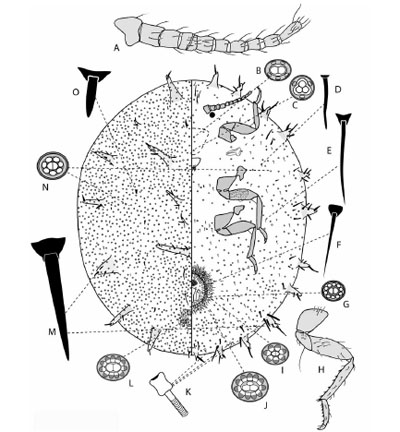
Crypticerya bursera Unruh 2008
Baja California
Cory Unruh describes a new species of scale insect in the genus Crypticerya in this week's Zootaxa. The diagram above shows a highly stylized version of the back (at left) and underbelly (at right) of the insect, with peripheral illustrations of the various pores, appendages and hairs. Scale insects have such an unusual morphology that the people who work on them have had to create a unique system for keeping track of their various characters. Most entomologists- myself included- require additional training to make sense of it.
Like all scale insects, Crypticerya bursera is a specialized plant feeder. The young insects have longer legs and are motile, but adult females become motionless blobs that plug into the phloem and drink sap. This species is known from a single locality in Baja California, where it was collected from an elephant tree (Bursera microphylla):

Source: Unruh, C. M. 2008. A taxonomic review of the Crypticerya species (Hemiptera: Coccoidea: Monophlebidae) of the southwestern United States and Mexico, including description of a new species from Baja California. Zootaxa 1759: 1-42.

If they cut down that particular elephant tree, will the species go extinct? I wonder if it was introduced from somewhere else.
Baja is a pretty poorly-collected part of the world, so it wouldn't surprise me if there are plenty more around on other Elephant trees.
Scale insects often cannot be identified without some time-consuming specimen preparation on slide mounts, so new species aren't often recognized until well after they were collected from the field.